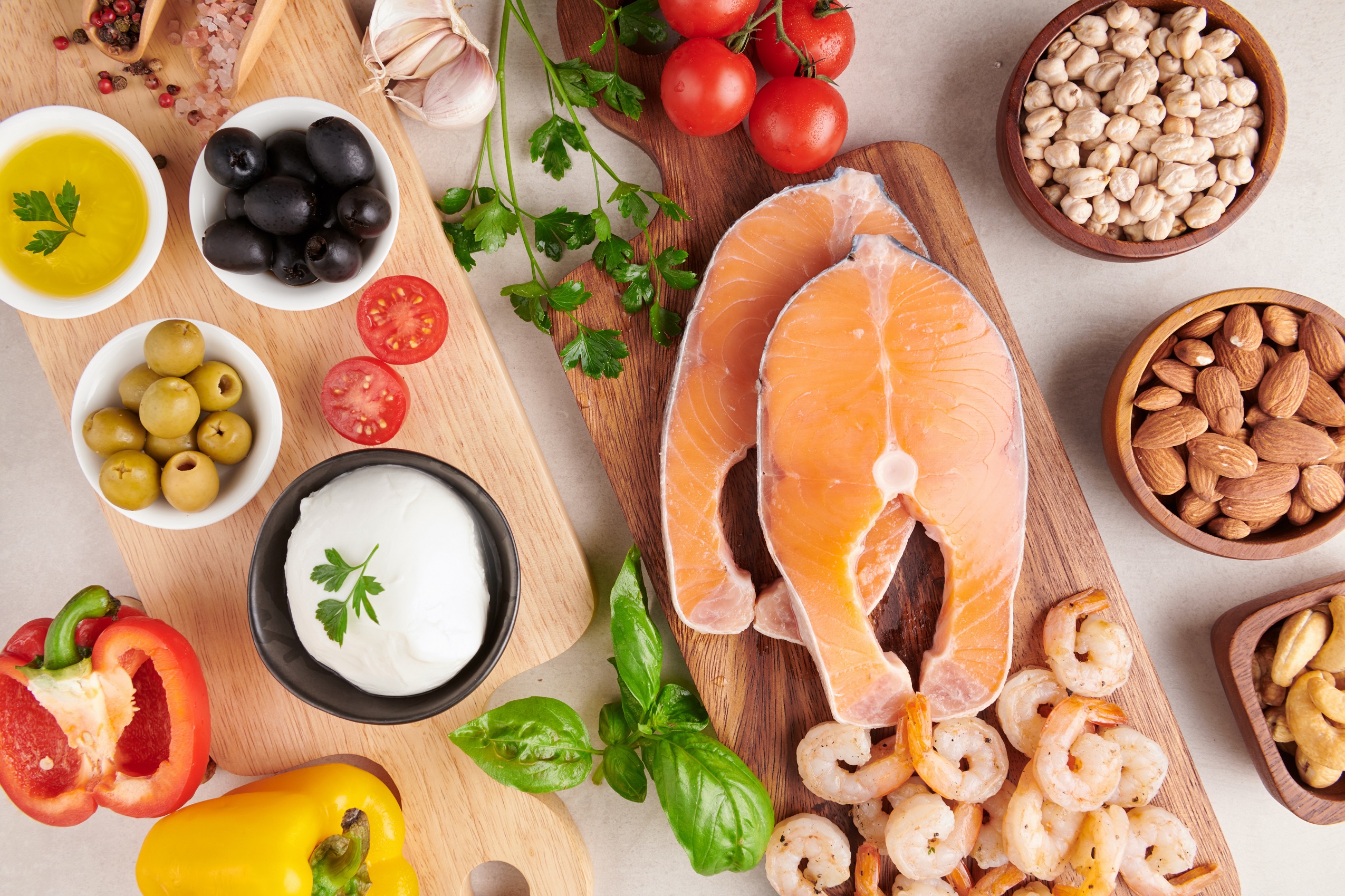If you are confused by the terminology of vegan, vegetarian or plant-based diets, not to worry, you are not alone! According to a vegan dietitian, Sarah Skovran, a Registered Dietitian Nutritionist (RDN), she mentioned that people easily to mixes up the names of different types of plant-based eating because we are not always using the consistent terminology to describe the type of diet. Another reason is that those words sound indistinguishable although they have an important dividing line, just like the distinction between vegan and vegetarian2. That being said, there are several variations of plant-based diets, and it really is a personal preference where some people will include eggs, dairy or fish in their eating styles.
| Type of diet | Description |
| Semi-vegetarian/ flexitarian | Includes eggs & dairy. May include minimal amount of meat, poultry, fish & seafood. |
| Pescatarian | Includes eggs, dairy, fish & seafood. Excludes meat & poultry. |
| Ovo-vegetarian | Includes eggs. Excludes meat, poultry, fish, seafood & dairy. |
| Lacto-vegetarian | Includes dairy. Excludes meat, poultry, fish, seafood & eggs. |
| Vegetarian/ lacto-ovo vegetarian | Includes eggs & dairy. Excludes meat, poultry, fish & seafood. |
| Vegan | Excludes all meat, poultry, fish, seafood, eggs & dairy. |
Vegetarian Etymology
The concept of vegetarianism can be traced back to as early as 500 BCE, first mentioned by Greek philosopher and mathematician Pythagoras and his followers whereby they promoted benevolence among all species, including humans5. The term of “vegetarian” was commonly used since the 1840-50s and its origin is from the word “vegetable” with the suffix “-arian” which stands for supporter or believer23.
Originally, vegetarians avoid consuming meat or other parts of an animal. Nevertheless, there are several different types of vegetarian diet, such as lacto-ovo, ovo- and lacto-. Lacto-ovo vegetarian is the most common Western vegetarian diet which forbids meat, poultry, fish, and seafood but allows the intake of animal produce such as dairy and eggs. In India, this type of eating diet is known as “Eggetarian”, a portmanteau of eggs and vegetarian18. Ovo-vegetarian diet excludes all animal-derived foods and by-products except for eggs and egg-containing foods like mayonnaise, egg noodles, and certain baked goods10. Lacto-vegetarian sometimes referred to as a lactarian is a diet which is “vegan plus dairy”, meaning that dairy products are included in the menu. This lacto-vegetarian diet is quite flexible and reduces the environmental impact20.
Completely Vegan
A vegan diet is like a vegetarian diet, in which it further excludes all animal foods such as meat (including fish, shellfish and insects), eggs and dairy. Nonetheless, veganism is not just about the diet, it is a philosophy and way of living which seeks to exclude—as far as is possible and practicable—all forms of exploitation of, and cruelty to, animals for food, clothing, or any other purpose19. The vegan diet terminology was coined in 1944 by a British woodworker named Donald Watson and his wife Dorothy Morgan to describe the concept of rejecting animal products for ethical reasons23.
In the 2010s, the vegan diet picked up in popularity and became mainstream where vegan staples like tempeh and tofu can now be found in supermarkets and local produce are more readily available with more interesting ways of cooking a vegan menu3. There was a 185% increase in vegan products launched in the UK between 2012 and 20167. Between 2015 and 2020, China became the fastest growing vegan market at 17.2%, followed by United Arab Emirates (10.6%) and Australia (9.6%)22. As of 2022, vegan meat or milk alternatives (or both) were mentioned in about 45% of food-based dietary guidelines11.
With the rising number of people reducing or eliminating animal-based sources of food, the main concern of this dietary approach is the risk of having nutritional deficiencies in omega-3 fatty acids, proteins, vitamin B12, iron, zinc, iodine, vitamin D and calcium which are mostly obtained from animal-based products. However, if the vegan diet is well-planned, it will be beneficial for lowering BMI, reducing body weight and improving some cardiometabolic markers especially for those with diabetes or has a high risk of cardiovascular diseases. Meanwhile, it has also shown to lower risk of cancer and all-cause mortality too16.

What is a plant-based diet?
A plant-based diet is defined as a diet consisting primarily of minimally processed fruits, vegetables, whole grains, legumes, nuts and seeds, herbs, and spices15. Poultry, beef, eggs, fish and dairy products can be added into plant-based diet with no set ratio of plant to animal foods but emphasis should be at least 2/3 of each plate being plants. A plant-based diet is a nutrient-dense diet and loaded with protein, healthy fats, fiber, vitamins, and minerals4.

Plant-based Market Insights
The rising trend of veganism and flexitarianism are the key factors driving the global plant-based food market size, growing from US$ 11.3 billion in 2023 to US$ 35.9 billion by 2033 with a CAGR of 12.2%6. Several plant-based food manufacturers are enthusiastically investing in research and development of novel plant-based food products from plant ingredients, such as egg substitutes, plant-based milk, and meat substitutes.
According to New Nutrition Business, one of its 2023 top three key trend – “Plants Made Convenient” highlighted that this is a growth trend with mass-market appeal, and it will be one of the biggest long-term growth trends. “The Plant Protein Paradox” became key trend number 6 in the 10 Key Trends 2023 of New Nutrition Business, this trend emphasized that innovation and R&D investment needed to create Gen 2 plant proteins which have better taste, nutrient density, and more creative marketing strategies14. Plant-based protein market is anticipated to grow at 7.3% CAGR (2022 – 2027) and is estimated to hit a market size of US$ 17.4 billion by 202712.
From Plant to Plate
Pulses such as faba beans or also known as fava or broad bean is a rising star in line with the current market trend for plant-based proteins. It has achieved a CAGR of 20% between 2016 and 202117. Besides this, faba bean ingredients also claim to be used in a clean label product21. The usage of Faba bean’s functional protein has spread across various categories including dairy alternative, bakery, sports nutrition, and breakfast cereals. Some product examples include protein enriched smoothies and vegan drinks. It has superb solubility and is a good alternative to animal and soy protein in certain applications1. At DPO International, we are honoured to be in partnership with Beneo to bring you the BeneoPro FB range of ingredients that offer distinguishable features for your food and beverage applications.
References
1Beneo. (n.d.) Sustainable Protein Enrichment with BeneoPro Faba Bean.
2Blumberg, P.O. (2022). Vegan, Vegetarian, and Plant-Based Are All Different. Here’s How. Men’s Health.
3CBS NEWS. (2011). Vegan Diets Become More Popular, More Mainstream.
4Columbia University Irving Medical Center. (2022). What is a plant-based diet, and is it healthy?
5Doucet, L. (2020). A Brief History of Veganism. Earthsave Canada.
6Future Market Insights (2023). Plant-based Food Market.
7Hancox, D. (2018). The unstoppable rise of veganism: how a fringe movement went mainstream. The Guardian.
8Harvard Health Publishing. (2021). The Right Plant-Based Diet for You.
9Henderson, L., (n.d.). Plant-based, vegetarian, and vegan diets. Heart Foundation.
10Hill, A. (2019). Ovo-Vegetarian Diet: A Complete Guide and Meal Plan. Healthline.
11Klapp, A., Feil, N. & Risius, A. (2022). A Global Analysis of National Dietary Guidelines on Plant-Based Diets and Substitutions for Animal-Based Foods. Current Developments in Nutrition. 6(11). https://doi.org/10.1093/cdn/nzac144.
12Markets and Markets (2022). Plant-Based Protein Market.
13Marrone, G., Guerriero, C., Palazzetti, D., Lido, P., Marolla, A., Di Daniele, F., & Noce, A. (2021). Vegan diet health benefits in metabolic syndrome. Nutrients, 13(3), 817. https://doi.org/10.3390/nu13030817.
14Mellentin, J. (2022). 10 Key Trends in Food, Nutrition & Health 2023. New Nutrition Business.
15Ostfeld, R.J. (2017). Definition Of a Plant-Based Diet and Overview of This Special Issue. J. of Geriatric Cardiology. 14: 315. doi:10.11909/j.issn.1671-5411.2017.05.008.
16Selinger, E., Neuenschwander, M., Koller, A., Gojda, J., Kühn, T., Schwingshackl, L., Barbaresko, J., & Schlesinger, S. (2022). Evidence of a vegan diet for health benefits and risks – an umbrella review of meta-analyses of observational and clinical studies. Critical Reviews in Food Science and Nutrition, 1–11. https://doi.org/10.1080/10408398.2022.2075311.
17Southey F. (2022). Beneo Builds New Pulse-Processing Plant for “Rising Star” Ingredient Faba Bean. Food Navigator Europe.
18Sula, M. (2019). Egg-O-Holic Puts Together Gujarat’s Vast Eggetarian Street Food. Chicago Reader.
19The Vegan Society. (n.d.). Definition of Veganism.
20TNN (2019). What is Lacto-Vegetarian Diet and What Are Its Benefits. ETimes.
21Vegconomist (2022). Interviews: BENEO: “Our Survey Revealed 1 in 4 Consumers Worldwide Identify as Flexitarian, and Half Are Interested in Plant-Based”.
22White, V. (2016). Euromonitor Launches New Ethical Labels Database. New Food Magazine.
23Wikipedia. (n.d.). Veganism.






